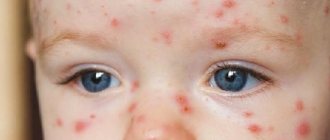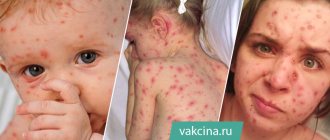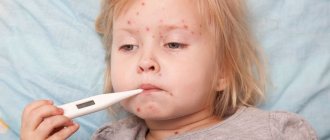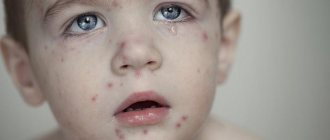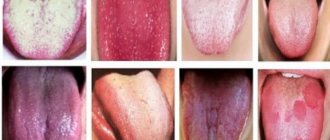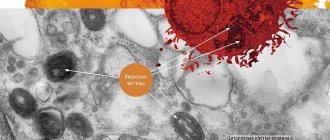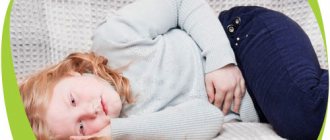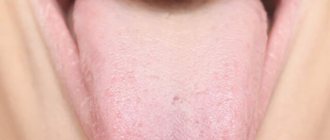December 07, 2020
Chickenpox is an infectious disease caused by the Varicella-Zoster virus (the third group of the herpes family). This disease is treated in children by a pediatrician, in adults by a therapist; the infection is characterized by a profuse itchy rash on the skin and surface of the mucous membranes.
Chickenpox is an infectious disease caused by the Varicella-Zoster virus (the third group of the herpes family). This disease is treated in children by a pediatrician, in adults by a general practitioner; the infection is characterized by a profuse itchy rash on the skin and surface of the mucous membranes. The incubation period for chickenpox can range from 10 days to 3 weeks. Chickenpox is highly contagious and the virus is transmitted through direct contact with a carrier.
Children often get sick in entire groups (groups in kindergarten or classes at school). When the virus first enters the human body, it provokes chickenpox, most often this occurs at the age of 3-6 years. Having chickenpox forms a stable immune response of the body to repeated infection; after 6 years of age, 70% of children already have stable immunity to this disease.
Once infected, the virus remains latent in nerve cells and can regenerate, causing a secondary infection called herpes zoster, also called “shingles.” It usually occurs in adults aged >50 years or in frail and immunocompromised individuals. Accompanied by a painful rash that can lead to permanent nerve damage.
Chickenpox symptoms
A rash all over the body is the main symptom of chickenpox, and this rash also appears on the mucous membranes. Chickenpox in the mouth is an enanthema. The child's temperature rises, general weakness appears, muscles and head ache. Usually this condition lasts 2-5 days. With chickenpox there may not be a fever - it all starts with a rash.
The incubation period for chickenpox is 10-21 days from the moment of infection. The disease usually lasts 5-10 days, although there are cases of the disease lasting 3 weeks.
With a mild form of chickenpox, the child may not be bothered by anything: he will be active and in a good mood, and only a small rash on the body will indicate that the baby is sick.
Chickenpox by day
Photos from open sources
The danger of chickenpox
Chickenpox is highly contagious - the virus is easily transmitted through tiny droplets of saliva and mucus when coughing, sneezing and talking. Many viral particles are also contained in the liquid from the opening vesicles, so you can become infected by touch. Due to such high contagiousness, chickenpox usually affects many children in children's institutions at once, becoming a frequent reason for quarantine. For the same reason, most people “manage” to get sick from it even in preschool age. If the first contact with the virus occurred in adulthood, the disease is often more severe - with high fever, general weakness and more rash.
How is chickenpox transmitted?
Most often, children from 3 to 7 years old suffer from chickenpox. In children under one year of age, adolescents and adults, chickenpox is a rare occurrence. The mode of transmission of chickenpox is airborne. The causative agent of the disease is herpes virus type 3 (varicella-zoster). This virus begins to rapidly multiply in the blood and lymph of the sick person, and when it ends up in the upper layers of the skin, the same rash of chickenpox appears.
Read also Epstein-Barr Virus: what it is and how to treat What is Epstein-Barr Virus and what drugs are prescribed for its treatment.
The causative agent of chickenpox
The main causative agent of chickenpox is the varicella zoster virus, which belongs to the general family of herpes viruses type 3.
Infection with the pathology occurs through the air through close interaction with a sick person.
The pathogen itself is very weak in the external environment, and if it does not penetrate the body, it dies instantly after 10 minutes.
If the virus infects the mucous membranes, the infection develops quickly. The pathogen spreads throughout the bloodstream, causing the appearance of characteristic clinical symptoms.
Complications of chickenpox
The main and dangerous complications of chickenpox are myocarditis and encephalitis. Such complications are typical for adults and those children who have weakened immune systems.
In addition to ordinary chickenpox, there are bullous, gangrenous and hemorrhagic forms. These are severe types of disease with complications. If the wounds become infected with a bacterial infection, another complication may develop - pyoderma. This complication often occurs in children.
The rash with ordinary chickenpox leaves no traces, but with such suppuration, scars are possible.
When to see a doctor?
Parents should call a doctor if:
- Child's age is less than 6 months
- Inflamed, red areas of skin appear around the blisters, which may indicate a secondary bacterial infection.
- Children become increasingly ill, they become drowsy, the temperature rises above 38C, and children drink little liquid or refuse to drink
- If your child feels unwell with a high fever and a skin rash that looks like small, bright red or purple spots or bruises that don't fade when you press on them, this may be a sign of meningococcal infection.
Chickenpox is not dangerous when parents know what to do, vaccinate their child in a timely manner, and quickly decide to call a doctor. After an illness, a fairly stable immunity develops, and the likelihood of recurrent illness is minimal.
In our medical center, you can consult with an immunoprophylaxis specialist or a pediatrician about when you should vaccinate your child or call a doctor at home if your baby suddenly gets sick.
Call a doctor at home Make an appointment with a doctor or call +7 (812) 331-17-74
How to treat chickenpox
Chickenpox is treated symptomatically: with antipyretic drugs, antihistamines in the form of tablets or ointments for external use. In some cases, taking antiviral medications is recommended to help the body fight off the infection faster. Mouth ulcers heal well with sea buckthorn oil and Solcoseryl ointment. You can also rinse your mouth with weak solutions of furatsilin, soda, and potassium permanganate. Herbal decoctions diluted with alcohol tinctures of propolis or calendula are also suitable.
Solcoseryl dental adhesive paste
Meda Pharma, Switzerland
Wound healing, angioprotective, membrane stabilizing, regenerating, cytoprotective, antihypoxic drug, which is available in the form of an injection solution, gel and ointment for external use.
from 172
1.0 1 review
1102
- Like
- Write a review
Preparations for treating skin ulcers relieve inflammation, disinfect, accelerate healing, dry, and reduce itching.
Rivanol
"Rivanol" is an antiseptic for external use in the form of a solution, effective in combating mainly coccal microorganisms (streptococci, staphylococci). It is these bacteria that usually cause complications with chickenpox (carbuncles, boils). "Rivanol" is used to spot treat ulcers 3-3 times a day. Contraindications: kidney problems and pregnancy.
Rivanol 0.1%
Dina+, UK
Rivanol is an antiseptic, has antimicrobial activity, fights coccal microorganisms, and is used in gynecology, urology, surgery, dermatology, and ophthalmology.
from 198
94
- Like
- Write a review
Drug treatment of chickenpox
Local therapy plays a special role in the treatment of rashes. It helps improve the healing of skin surfaces, preventing the appearance of scars, cicatrices and secondary infection of pimples.
It is advisable to treat skin lesions with any antiseptic agents. These are brilliant green, Tsindol, Baneotsin, Fukortsin. This group of drugs eliminates re-infection of elements, promotes their rapid drying and epithelization.
The most modern medicine is Calamine. It is applied topically and has a complex antiallergic and antiseptic effect.
Also prescribed for the treatment of the infectious process:
- Antipyretic drugs. Reduces temperature and improves well-being.
- Antiviral agents. They are used to destroy the main infectious agent.
- Antihistamines. Suppresses severe itching and prevents other signs of allergies. Used for oral and external use.
- Painkillers. Fight headaches and throat discomfort. Used in tablet form.
When localizing papular elements in the oral cavity, it is recommended to use:
- Boric acid 1% as an antiseptic.
- Kamistad, Kalgel and other painkillers.
- Sea buckthorn oil or Solcoseryl to reduce irritation and accelerate epithelization.
Tsindol
“Tsindol” for chickenpox perfectly relieves inflammation, disinfects wounds, and dries out burst blisters. The suspension should be used to treat the rash 3-5 times a day, depending on the severity of the condition. "Tsindol" is completely safe, so it is prescribed to children under one year of age and to pregnant women. The only contraindication is intolerance to zinc oxide.
Tsindol
Yaroslavl Pharmaceutical Factory, Russia
Diaper rash, diaper rash, prickly heat, dermatitis, ulcerative skin lesions, superficial wounds, eczema in the acute phase, herpes simplex, streptoderma, trophic ulcers, burns, bedsores.
from 36
504
- Like
- Write a review
Calamine
Calamine topical lotion is based on zinc and calamine oxide. The medicine for chickenpox relieves itching, irritation and inflammation well, and works as an antiseptic. “Calamine” is also as harmless as possible, but is not suitable for those who have individual sensitivity to zinc.
Calamine
The drug Calamine lotion is used in dermatological practice, in the treatment of diseases accompanied by itchy skin.
Therefore, the lotion is prescribed for the complex treatment of chickenpox, eczema, and psoriasis. Used for dermatitis, acne, herpes. Used in the treatment of skin rashes, herpes zoster, urticaria, rubella, etc. from 219
765
- Like
- Write a review
Furacilin
Wounds with chickenpox should be treated with a 0.02% solution of Furacilin 3-4 times a day (it is better to use a cotton pad). The product relieves inflammation, kills germs, and dries wounds well. "Furacilin" can also be used for ulcers on the mucous membranes.
Furacilin solution
Samaramedprom OJSC, Russia; PJSC "Biosintez", Russia; JSC Dalkhimfarm, Russia; Vips-Med, Russia
Externally: purulent wounds, bedsores, stage II – III burns, minor skin damage (including abrasions, scratches, cracks, cuts).
Locally: blepharitis, conjunctivitis, boil of the external auditory canal; osteomyelitis, empyema of the paranasal sinuses, pleura (washing the cavities); acute external and otitis media, tonsillitis, stomatitis, gingivitis. from 36
5.0 1 review
28
- Like
- Write a review
Chlorhexidine
"Chlorhexidine" (or its analogue "Miramistin") for chickenpox is applied to the vesicles 2-3 times a day. The product is also suitable for rinsing your mouth. "Chlorhexidine" is a broad-spectrum antiseptic with antimicrobial and antifungal effects.
Chlorhexidine
Update, Russia
Prevention of sexually transmitted infections (chlamydia, ureaplasmosis, trichomoniasis, gonorrhea, syphilis, genital herpes).
Disinfection of purulent wounds, infected burn surfaces; treatment of infections of the skin and mucous membranes in surgery, obstetrics and gynecology, urology (urethritis, urethroprostatitis), dentistry (gingivitis, stomatitis, aphthae, periodontitis, alveolitis). from 800
1016
- Like
- Write a review
Poksklin
Cooling mousse "Poksklin" for chickenpox has a completely natural base (panthenol, aloe vera, chamomile and lavender). The product cools and reduces scratching, so scars do not form. “Poksklin” relieves inflammation, has an antiseptic effect and accelerates the healing process of wounds.
Poksklin
PharmaVal AS, Netherlands
Poksklin cooling hydrogel was developed to relieve the symptoms of chickenpox over large areas of the body.
While spreading thick creams and ointments over the body can damage the blisters, the cooling hydrogel is very easy to apply and does not cause friction in sensitive areas when applied to the skin. PoxClean provides an immediate cooling effect, which significantly relieves itching. For this purpose, it can be used as many times as necessary. PoxClean contains the ingredient 2QR, a biologically active antibacterial complex. This component helps your child's natural skin immunity to block harmful bacteria. The antibacterial component in PoxClean is a polysaccharide obtained from the plant extract of Aloe Vera. It creates a barrier on the skin, thereby preventing the penetration and spread of bacteria on the surface of the skin. from 272
5.0 1 review
204
- Like
- Write a review
CHICKENPOX IN CHILDREN: SYMPTOMS, COURSE, TREATMENT
Home — Social networks — CHICKENPOX IN CHILDREN: SYMPTOMS, COURSE, TREATMENT
CHICKENPOX IS A DISEASE THAT IS NOT LOSSING ITS POPULARITY. WHOLE KINDERGARTENS AND FAMILIES HAVE IT: CHILDREN, ADULTS, FUTURE MOMS. BUT DESPITE THE FELLOWSHIP, THE SYMPTOMS AND TREATMENT OF CHICKENPOX IN CHILDREN AND ADULTS CONTINUE TO CAUSE MANY QUESTIONS. TODAY OUR EXPERTS WILL ANSWER THE MOST COMMON OF THEM.
WHAT IS CHICKENPOX
Varicella zoster virus is a type of herpes. More precisely: the herpetic virus varicella zoster (Varicella zoster), the 3rd type of herpes viral infection. The signature sign of chickenpox is a blistering rash that often covers the entire body (although there are also cases of localized rashes). In the past, each such pimple was supposed to be smeared with brilliant green, so in our country chickenpox is firmly associated with children with green spots. Dr. Komarovsky even has a joke about this: “A spotted green rash is a characteristic symptom of chickenpox.” When the blisters burst, they cause itching, which can lead to scratching and secondary infection of the wounds. The “favorite” season of the disease is considered to be autumn-winter, and epidemic outbreaks are recorded once every 5 years.
Chickenpox predominantly affects children aged 1 to 10-12 years, and the majority of cases are among children 3-4 years old.
HOW INFECTION WITH CHICKENPOX OCCURS
Susceptibility to the chickenpox virus is very high because it is very volatile - it covers distances of up to 20 m, from floor to floor, through ventilation. Chickenpox is transmitted through the mucous membranes of the eyes and upper respiratory tract. But the virus has several ways of entering someone else’s body from a patient. The virus literally travels with the wind: through airborne droplets - when talking, coughing, crying loudly, or screaming. It spreads through contact and household contact - infection with saliva or fluid from a pimple. Transmitted by direct touch. A pregnant woman with chickenpox can infect her child, since the virus passes transplacentally, that is, through the placental barrier from mother to fetus.
To become infected with chickenpox, it is enough to communicate with someone who has chickenpox or someone who has shingles (herpes zoster), and chickenpox infection will occur even with fleeting contact with him. The period of contagiousness of chickenpox in patients begins at the end of the incubation period (48 hours before the appearance of the rash) and continues until the 5th day from the moment the last pimple appears. Moreover, the incubation period of chickenpox in children and adults is not typical at all and does not manifest itself in any way for 1-3 weeks (at least 7 days), so it is impossible to say exactly when those same 48 hours before the appearance of acne will occur.
INCUBATION PERIOD OF CHICKENPOX
The incubation period, that is, the time from the moment of introduction to the first signs of chickenpox, is 11-23 days. During this period, the pathogen penetrates through the mucous membrane of the upper respiratory tract, then multiplies and accumulates in the epithelial cells of these mucous membranes.
After the maximum accumulation of the chickenpox pathogen, it spreads through the lymphatic and blood vessels.
In some patients (there are very few of them), the end of the incubation period is marked by scarlet-like rashes. This may be the first sign of chickenpox in children and adults. This condition lasts literally one day, several hours, then the rash disappears, the temperature rises to 37-38⁰C.
WHEN DOES THE RASCH APPEAR DURING CHICKENPOX?
After the incubation period, the period of rash begins. These are the most obvious and first signs of chickenpox in children and adults. The period of rash lasts for 3-5 days, while the lymph nodes enlarge, the temperature rises to 37-39°C, persisting throughout the entire period of the rash. Also, each new outbreak of rashes is usually accompanied by a rise in temperature.
WHAT DOES THE RASHE (ACNE) LOOK LIKE WITH CHICKENPOX
A rash with chickenpox appears on the 1st day of the onset of intoxication, with breakouts (the appearance of new pimples) within 5 days - some pimples are already going away, while others are just appearing. Therefore, it seems that the patient has pimples of different types: blisters, spots, and crusts at the same time.
The rash does not have a favorite localization; rashes can even be on the scalp, on the mucous membrane of the mouth, genital organs in girls and women, conjunctiva/cornea, and larynx. All these pimples mature and heal within 5 days, and the rash is accompanied by itching of varying intensity. Against itching, various doctors recommend using antihistamines, wet wraps or even baths. During the first day, the red spot turns into a blister and after a couple of days the rash looks on the surface of the body like “dew drops” with transparent contents, which becomes cloudy after 1-2 days, and after another 1-2 days the blister dries out and turns into a crust that falls off after 1-3 weeks.
WHY ARE PIMLES LUBRICATED WITH ZELENKA
As Dr. Komarovsky wittily noted, speaking about chickenpox: “Painting a child with brilliant green is a personal matter for his parents, determined by their love of painting and has nothing to do with treatment.” In fact, brilliant green does not treat chickenpox rash, but is a medical marker with which the appearance of new pimples on the patient’s body is noted. As soon as new objects for staining with brilliant green stop appearing on the skin of a child with chickenpox, and old pimples have crusted over, that’s it, the child is no longer contagious. Nowadays, pimples are smeared with brilliant green only by those who firmly believe that it is one of the mandatory means of treating chickenpox. But this is a misconception. You can't cure pimples, you can only wait until they go away on their own. To avoid secondary infection of the skin, it is necessary to prevent scratching in the area of acne. To do this, you need to purchase other drugs from pharmacies that are specially created to eliminate symptoms of such diseases. They relieve itching, dry, have a cooling effect and, by the way, are also not completely colorless.
WHEN DOES A PATIENT WITH CHICKENPOX STOP BEING INFECTIOUS?
A patient with chickenpox ceases to be contagious as soon as the appearance of new pimples has stopped, and crusts have already formed on all existing ones. The recovery period lasts for 3 weeks from the end of the rash and is characterized not only by the falling off of the crusts, but also by the formation of lifelong immunity. After the crusts fall off, dark spots remain, which disappear within a few weeks. There are no scars left unless there is a secondary infection.
CHICKENPOX IN INFANTS
Breastfed newborns up to 6 months usually do not get sick due to antibodies received from the mother, but only if the mother herself has previously had chickenpox or has been vaccinated. If the mother has not passed on these antibodies to the baby (not having them herself), then the baby may get chickenpox. Please note that we are talking specifically about breastfed babies. Formula-fed babies do not have such antibody protection.
In a sick infant, the disease is severe. Against the background of high temperature, intracranial pressure may increase, which will be indicated by visible pulsation of the fontanel and convulsions. The rashes in such babies are profuse and the maturation of the rash proceeds more slowly, becoming protracted - up to 9 days, instead of 5. Bacterial complications often occur.
For this reason, all newborns whose mothers have not had chickenpox or were infected a few days before birth, as well as all premature babies under 1 kg, regardless of the mother’s infectious history, must be administered a special immunoglobulin. This is not a vaccination against chickenpox, but temporary protection against it until the child is strong enough to cope with this virus on his own, unless, of course, the mother chooses vaccination over the disease.
It is worth noting that children who are not in a group, children under 3 years of age, as a rule, very rarely have the opportunity to become infected with chickenpox. Adults also rarely get this disease.
IS IT DIFFICULT TO IDENTIFY CHICKENPOX?
In typical cases (and this is the majority of cases of chickenpox), the diagnosis of the disease is established on the basis of characteristic clinical data of the disease. The clinical picture of chickenpox is so typical that there is simply no need for additional diagnostics.
However, in some cases, when the disease does not proceed in a completely typical manner, it may be necessary to carry out a differential diagnosis of chickenpox with other viral infectious diseases, mainly those that are accompanied by similar symptoms. We are talking, first of all, about influenza, parainfluenza, measles; in some cases, differential diagnosis with rubella may be required. For this, a blood test is done.
IS IT POSSIBLE TO CONFUSE CHICKEN POX AND RUBELLA?
The doctor, of course, will not confuse these diseases. For doubting patients, you need to keep in mind their obvious differences. With chickenpox, a polymorphic rash is most often observed, that is, spots, crusts, and blisters are simultaneously present on the skin. With rubella, only a pinkish rash can be observed. With chickenpox, the temperature can rise to 40°C; with rubella, it occasionally reaches 39°C. The rubella virus is dangerous for the fetus; the chickenpox virus does not pose such an acute danger to pregnant women. Chickenpox can be complicated by inflammatory phenomena on the skin, but this does not happen with rubella. Chickenpox rarely goes away with catarrhal symptoms; with rubella, redness of the pharynx and catarrh of the upper respiratory tract almost always occur.
HOW TO TREAT CHICKENPOX IN CHILDREN?
If a child of the first year gets sick with chickenpox, treatment is carried out only under the supervision of a doctor with possible hospitalization
, because the course of infectious processes in young children is prone to generalization, frequent and severe complications and high mortality!
In children aged 2 to 10-12 years after diagnosis (with primary chickenpox), specific treatment for uncomplicated chickenpox is not carried out (and patients are not painted with brilliant green). All manipulations with a patient with chickenpox are associated with the relief of symptoms, namely: reducing the temperature with antipyretics (except aspirin) and relieving skin itching, if any. If the child does not look lethargic, if his temperature is not too high, then you should not convince him that he is very sick and needs bed rest. Children under 10-12 years of age suffer from chickenpox quite easily. And the only thing that usually torments them is the itching of the chickenpox rash. This problem is solved by using antihistamines.
To prevent the child from scratching the skin in areas of chickenpox rash, parents will have to monitor him and distract him. It is also necessary to monitor the child’s nails, and very young children can wear special mittens - “scratchies”. There is also a “grandmother’s” way to help a child with severe itching, even if antihistamines do not help - this is a feather. In the past, children were relieved of itching with a goose feather - with its help, mothers “scratched” especially disturbing places on the skin, without creating scratches.
A month after recovery from chickenpox, the doctor examines the patient, with an appointment for an immunological examination and specialist examination. Preventive vaccinations cannot be given within 1 month.
IS QUARANTINE FOR CHICKENPOX REQUIRED?
In the not-too-distant past, quarantine due to chickenpox was as commonplace as wearing war paint with brilliant green on children affected by this virus. But now, when there is a mass incidence of chickenpox, kindergartens and schools are usually not closed for quarantine. Groups and classes in which children with chickenpox have been identified continue to function, but they may be subject to temporary (up to three weeks) bans on outings, on contacts with children from other groups (classes), as well as on the admission of new children to them .
Fenistil
"Fenistil" is a safe antihistamine (antiallergic) drug of a new generation. To reduce the itching of chickenpox, antihistamines are used, this is especially true for children who cannot control themselves and scratch the wounds. It is not advisable to use Fenistil gel for chickenpox, since due to the treatment of large areas of the body it can be toxic to the body. But Fenistil drops for chickenpox are a good way to relieve itching. The number of drops is calculated based on the patient's weight.
Fenistil
GlaxoSmithKline, GSK, UK
The antiallergic effect of Fenistil is associated with competitive blockade of H1-histamine receptors.
Symptomatic treatment of allergic diseases such as: urticaria; allergic rhinitis; food allergies; drug allergy. Elimination of itching from: insect bites; chicken pox; atopic dermatitis. from 237
5.0 1 review
1134
- Like
- Write a review
Treatment
If pathology is diagnosed, then treatment of chickenpox in children should be symptomatic. Young patients are given antipyretics if the temperature exceeds 38.5. Medicines that reduce itching are also prescribed, for example, antihistamines such as diazolin, suprastin and some others (as prescribed by a doctor).
In addition, the blisters are lubricated with a solution of brilliant green, due to which they dry out, itch less and heal faster. It would be correct to use drugs that enhance immunity to treat chickenpox. But in adult patients, chickenpox, a type of herpes virus, is treated with Acyclovir.
Cetirizine
Doctors often prescribe Cetirizine (Zyrtec) for chickenpox. For children - in drops, for adults - in tablets. The drug relieves symptoms well in itchy allergic dermatoses, has no contraindications and is usually well tolerated.
Cetirizine
JSC VERTEX, Russia
seasonal and year-round allergic rhinitis and conjunctivitis (itching, sneezing, rhinorrhea, lacrimation, conjunctival hyperemia);
urticaria (including chronic idiopathic urticaria); hay fever (hay fever); itching; angioedema (Quincke's edema); itchy allergic dermatoses. from 36
511
- Like
- Write a review
Fenkarol
Fenkarol is a relatively new anti-allergy drug on the pharmaceutical market, but has already proven its effectiveness and safety. The product is good at relieving itching and inflammation due to chickenpox. Typically, Fenkarol is well tolerated and has no side effects. The only contraindication is pregnancy.
Fenkarol
Olaina Chemical Plant, Latvia
- hay fever;
- acute and chronic urticaria; - angioedema; - allergic rhinitis; — dermatoses (including eczema, psoriasis, atopic dermatitis); — neurodermatitis; - skin itching. from 176
478
- Like
- Write a review
The drug Cycloferon
The most studied and well-proven immunostimulant in clinical practice is the original domestic drug cycloferon. Its active ingredient - methylglucamine acridone acetate - stimulates the production of interferons alpha, beta and gamma - protective molecules that are secreted by the body's cells in response to the invasion of viruses. Cycloferon changes the vital processes of the cell in such a way that it becomes immune to the virus and does not participate in its reproduction, and also activates immune cells - lymphocytes and macrophages.
